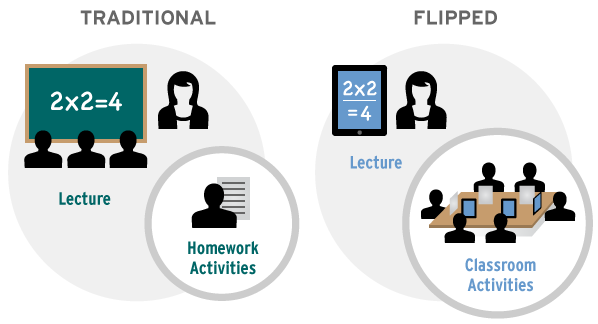The pandemic has overturned education. Learning needs have only grown during the past year especially with a large number of kids having no access to proper digital infrastructure, or having to share infrastructure like space and devices with their siblings or friends. This brings us to a very important question – will the existing framework still stay valid when students get back to school after the pandemic. Higher school education, where children will graduate into the most important aspects or even defining moments of their lives. There is a pressing need for something innovative, new and creative yet simple and accessible to all. Enter flipped learning.
What exactly is flipped learning?
Flipped learning in it’s simplest form is a guided learning approach where students watch pre-recorded videos at home (like on Coursera or YouTube) and then attends class – either online or offline in the classroom. The class is used for activities, question and answer sessions, discussions, debates or deliberations.
Does it sound confusing? Compare it with traditional pedagogy. Students get introduced to concepts in the class first, and then through homework, assignments or activities, they understand it better. But in flipped learning, the student as an individual is introduced to concepts and ideas, which are explored further and worked upon as group activities in the classroom.
Traditional learning vs flipped learning:
At Sri Prakash Synergy School, recognized as the best international school in Andhra Pradesh, we invest in creative methods of teaching that add value to students’ learning. Our faculty are trained constantly on best practices in teaching and imparting education of the highest standards. We use international teaching methodologies while staying rooted to Indian values. One such method we have come across is the idea of flipped learning. It is in early exploratory stages at SPSS.
- Existing frameworks operate on a principle that information is available at few sources and knowledge of it is vital. Flipped learning take sit a step further, and believes that with the internet, knowledge and information is available to all freely, it is what we do with the information that matters.
- Traditional frameworks believe that students owing to their age have to be administered learning through dictated methods. Flipped learning is more immersive, as it trusts that the student in higher classes is more mature to learn basics by themselves and can self-regulate. It believes that basics can be learnt by the students by themselves and teachers can help build on them – thus creative a more intense and richer knowledge base.
- Existing methods assume that students come into the class unprepared and knowing nothing, and it is the teacher who needs to teach. Flipped learning believes in preparation. Coming prepared to a class with prior learning – even if the learning has some gaps, or is flawed is better than not learning anything at all. This could be through reading material, videos or interactive medium.
What value does flipped learning add?
Higher education has been a major area of concern in the Indian education system. Everyone agrees that there is a huge employ-ability problem, and has views on how the system needs to be fixed. On one hand we have the pandemic playing havoc as illiteracy and school drop-out rates increase owing to the economic catastrophe caused by the CoVID-19 crisis.
Things may go back to normal, things may never be the way they were we would never know. But time is running out, and learning should never wait.
Blended teaching
We can no longer assume that we have unlimited access to spaces or locations to get together and learn under one roof. It could be virtual for a while. Even later, flipped learning combined with blended learning gives the student flexibility – to learn without missing out on classes.
Inclusivity
Flipped learning is a tool aided by technology. It helps reach a child in the remotest corner of the country with the right infrastructure. Lecturing is done online, while activities are done in real time online or offline through classrooms.
Lower cost
Imagine the power this has. Technology infrastructure needs lesser investment and is way economical than physical infrastructure. Even the Capital intensive costs work out over time. And the returns are tremendous.
If nothing, this model could be an opportunity to get rid of outdated frameworks. Explore newer teaching methods that are more efficient, better and equitable.
Higher education is crucial for the student, and also for the country’s overall future. This could be a path breaking methodology that educational institutions must definitely consider. The best CBSC School in Andhra Pradesh, always strives towards excellence through innovation and creativity and adding value to education, and flipped learning is one such tool that adds value.


